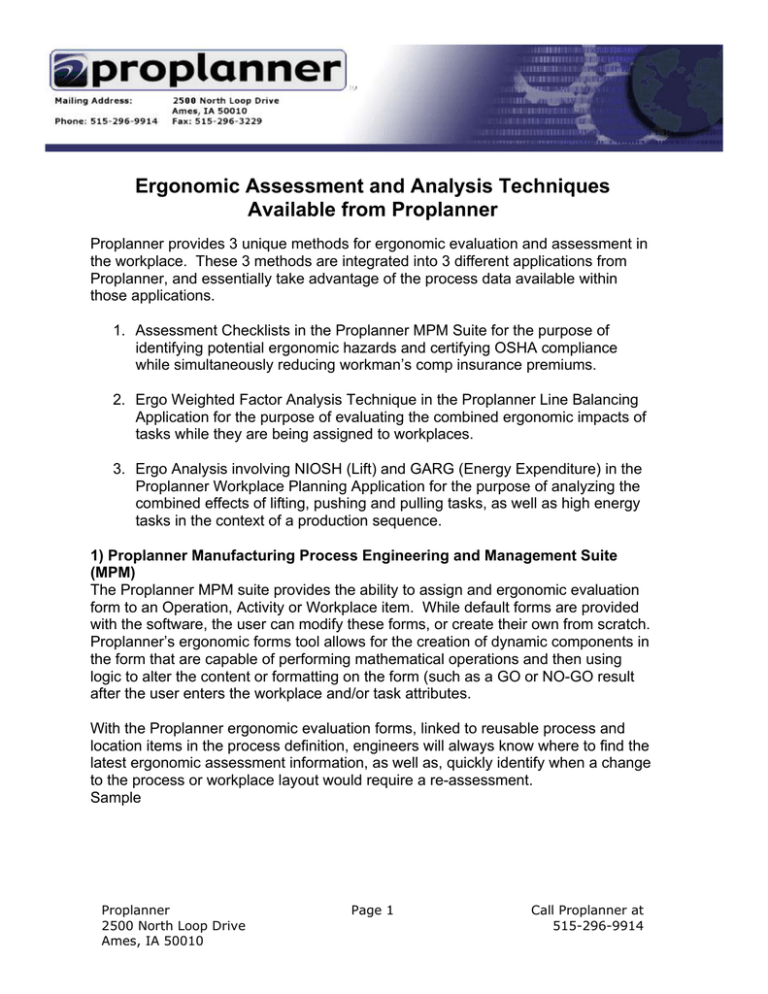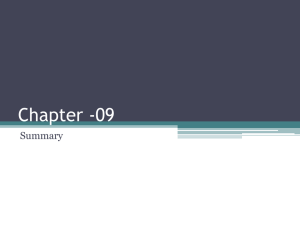Ergonomic Assessment and Analysis Techniques Available from Proplanner
advertisement

Ergonomic Assessment and Analysis Techniques Available from Proplanner Proplanner provides 3 unique methods for ergonomic evaluation and assessment in the workplace. These 3 methods are integrated into 3 different applications from Proplanner, and essentially take advantage of the process data available within those applications. 1. Assessment Checklists in the Proplanner MPM Suite for the purpose of identifying potential ergonomic hazards and certifying OSHA compliance while simultaneously reducing workman’s comp insurance premiums. 2. Ergo Weighted Factor Analysis Technique in the Proplanner Line Balancing Application for the purpose of evaluating the combined ergonomic impacts of tasks while they are being assigned to workplaces. 3. Ergo Analysis involving NIOSH (Lift) and GARG (Energy Expenditure) in the Proplanner Workplace Planning Application for the purpose of analyzing the combined effects of lifting, pushing and pulling tasks, as well as high energy tasks in the context of a production sequence. 1) Proplanner Manufacturing Process Engineering and Management Suite (MPM) The Proplanner MPM suite provides the ability to assign and ergonomic evaluation form to an Operation, Activity or Workplace item. While default forms are provided with the software, the user can modify these forms, or create their own from scratch. Proplanner’s ergonomic forms tool allows for the creation of dynamic components in the form that are capable of performing mathematical operations and then using logic to alter the content or formatting on the form (such as a GO or NO-GO result after the user enters the workplace and/or task attributes. With the Proplanner ergonomic evaluation forms, linked to reusable process and location items in the process definition, engineers will always know where to find the latest ergonomic assessment information, as well as, quickly identify when a change to the process or workplace layout would require a re-assessment. Sample Proplanner 2500 North Loop Drive Ames, IA 50010 Page 1 Call Proplanner at 515-296-9914 Risk Factor Checklist (Default form in MPM Suite) Workstation Design Oriented Ergo Assessment Proplanner 2500 North Loop Drive Ames, IA 50010 Page 2 Call Proplanner at 515-296-9914 Common UAW Approved Checklist (English) Common UAW Approved Checklist (Spanish) Proplanner 2500 North Loop Drive Ames, IA 50010 Page 3 Call Proplanner at 515-296-9914 2) Line Balancing Weighted Factor Analysis The Proplanner Line Balancing application (both in integrated and standalone versions) allows the engineer to classify the potential ergonomic stresses of a particular task using 10 different attributes. These attributes are retained as properties of the task when that task is reassigned to a workplace (either automatically or manually) within the Line Balancing Application. The Line Balancing application will then aggregate these ergonomic attributes for each workplace to determine the potential for cumulative ergonomic problems, at an early stage in the production design process when task re-assignment is easiest and cheapest to do. Screen for Assigning Ergo Attributes to Process Tasks Screen for Workplace Aggregation of Ergo Attributes Proplanner 2500 North Loop Drive Ames, IA 50010 Page 4 Call Proplanner at 515-296-9914 3) Workplace Planner NIOSH (Lift) and GARG (Energy Expenditure) Analysis The Proplanner Workplace Planner application includes the optional ability to define the attributes of a lifting, or placement, task using the OSHA approved NIOSH technique. From this task definition, the Workplace Planner computes the CLI (Combined Lifting Index) for each operator, as well as the Kilo Calorie expenditure for that operator for their entire working shift. In addition, a Push and Pull stress analysis, similar to that defined in the SNOOK method, will be incorporated in a later version of the software. While not typically performed for all operators in all workplaces, the Lift and Energy analysis capability allows the engineer to evaluate the detailed aspects of work tasks for operators that have been identified as being ‘At Risk’ using one of the prior ergonomic assessment techniques described earlier in this document. By integrating the Lifting attributes as a property of the task, it is easy to re-assign tasks throughout the facility and then re-aggregate and analyze the cumulative aspects of the workstation work content for any operator with minimal, to no, redundant data entry. Lift and Energy Analysis for an Operator Proplanner 2500 North Loop Drive Ames, IA 50010 Page 5 Call Proplanner at 515-296-9914






